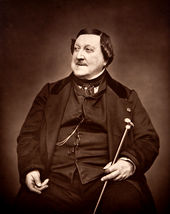 On this day in 1868, composer, The Italian Mozart, Gioachino Rossini, died at his country house at Passy, France at the age of 76. Born Gioachino Antonio Rossini on 29 February 1792 in Pesaro, Italy. Best known for his 39 operas which inlcude Il barbiere di Siviglia (The Barber of Seville), Guillaume Tell (William Tell) and La cenerentola (Cinderella). A 30-year-old Rossini met Ludwig van Beethoven, then aged 51, in 1822. Communicating in writing, Beethoven noted: “Ah, Rossini. So you’re the composer of The Barber of Seville. I congratulate you. It will be played as long as Italian opera exists. Never try to write anything else but opera buffa; any other style would do violence to your nature.” That same year Rossini married the renowned opera singer Isabella Colbran. She died in 1845 and on 16 August 1846, he married Olympe Pélissier. During his life Rossini was photographed by Félix Nadar and Etienne Carjat and had his portrait painted by Giorces, Vincenzo Camuccini and Francesco Hayez. I saw Houston Grand Opera’s production of La cenerentola in October of 1995 with Cecilia Bartoli in the role of Angelina (Cinderella). I fell in love with opera, and Miss Bartoli, that night.
On this day in 1868, composer, The Italian Mozart, Gioachino Rossini, died at his country house at Passy, France at the age of 76. Born Gioachino Antonio Rossini on 29 February 1792 in Pesaro, Italy. Best known for his 39 operas which inlcude Il barbiere di Siviglia (The Barber of Seville), Guillaume Tell (William Tell) and La cenerentola (Cinderella). A 30-year-old Rossini met Ludwig van Beethoven, then aged 51, in 1822. Communicating in writing, Beethoven noted: “Ah, Rossini. So you’re the composer of The Barber of Seville. I congratulate you. It will be played as long as Italian opera exists. Never try to write anything else but opera buffa; any other style would do violence to your nature.” That same year Rossini married the renowned opera singer Isabella Colbran. She died in 1845 and on 16 August 1846, he married Olympe Pélissier. During his life Rossini was photographed by Félix Nadar and Etienne Carjat and had his portrait painted by Giorces, Vincenzo Camuccini and Francesco Hayez. I saw Houston Grand Opera’s production of La cenerentola in October of 1995 with Cecilia Bartoli in the role of Angelina (Cinderella). I fell in love with opera, and Miss Bartoli, that night.
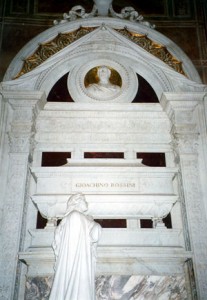 The Final Footprint – Rossini was entombed in the Rossini Private Mausoleum in Cimetière du Père Lachaise, Paris, Ile-de-France Region, France. In 1887, his remains were moved and entombed in the Basilica di Santa Croce, in Florence, at the request of the Italian government. The Basilica di Santa Croce (Basilica of the Holy Cross) is the principal Franciscan church in Florence, and a minor basilica of the Roman Catholic Church. It is situated on the Piazza di Santa Croce. It is the burial place of some of the most famous Italians; Michelangelo, Galileo, Machiavelli, and is known also as the Temple of the Italian Glories (Tempio dell’Itale Glorie). His private mausoleum remains unoccupied at Père Lachaise. Père Lachaise is the largest cemetery in Paris and one of the most visited cemeteries in the world. Bravo Rossini!
The Final Footprint – Rossini was entombed in the Rossini Private Mausoleum in Cimetière du Père Lachaise, Paris, Ile-de-France Region, France. In 1887, his remains were moved and entombed in the Basilica di Santa Croce, in Florence, at the request of the Italian government. The Basilica di Santa Croce (Basilica of the Holy Cross) is the principal Franciscan church in Florence, and a minor basilica of the Roman Catholic Church. It is situated on the Piazza di Santa Croce. It is the burial place of some of the most famous Italians; Michelangelo, Galileo, Machiavelli, and is known also as the Temple of the Italian Glories (Tempio dell’Itale Glorie). His private mausoleum remains unoccupied at Père Lachaise. Père Lachaise is the largest cemetery in Paris and one of the most visited cemeteries in the world. Bravo Rossini!
 On this day in 1903, Danish-French Impressionist and Neo-Impressionist painter Camille Pissarro died in Paris at the age of 73. Born Jacob Abraham Camille Pissarro on 10 July 1830 in Charlotte Amalie, Saint Thomas, Danish West Indies (now US Virgin Islands). Pissarro’s importance resides in his contributions to both Impressionism and Post-Impressionism. He studied with Gustave Courbet and Jean-Baptiste-Camille Corot, and later studied and worked alongside Georges Seurat and Paul Signac when he took on the Neo-Impressionist style at the age of 54. In 1873 he helped establish a collective society of fifteen aspiring artists, perhaps becoming the leading figure in holding the group together and encouraging the other members. Art historian John Rewald called Pissarro the “dean of the Impressionist painters”, not only because he was the oldest of the group, but also “by virtue of his wisdom and his balanced, kind, and warmhearted personality”. Cézanne said “he was a father for me. A man to consult and a little like the good Lord,”. Pissarro apparently was one of Gauguin’s masters. Renoir referred to his work as “revolutionary”, through his artistic portrayals of the “common man”, as Pissarro insisted on painting individuals in natural settings without “artifice or grandeur”. Pissarro is the only artist to have shown his work at all eight Paris Impressionist exhibitions, from 1874 to 1886. In 1871 he married his mother’s maid, Julie Vellay, a vineyard grower’s daughter, with whom he would later have seven children. They lived outside of Paris in Pontoise and later in Louveciennes, both of which places inspired many of his paintings including scenes of village life, along with rivers, woods, and people at work.
On this day in 1903, Danish-French Impressionist and Neo-Impressionist painter Camille Pissarro died in Paris at the age of 73. Born Jacob Abraham Camille Pissarro on 10 July 1830 in Charlotte Amalie, Saint Thomas, Danish West Indies (now US Virgin Islands). Pissarro’s importance resides in his contributions to both Impressionism and Post-Impressionism. He studied with Gustave Courbet and Jean-Baptiste-Camille Corot, and later studied and worked alongside Georges Seurat and Paul Signac when he took on the Neo-Impressionist style at the age of 54. In 1873 he helped establish a collective society of fifteen aspiring artists, perhaps becoming the leading figure in holding the group together and encouraging the other members. Art historian John Rewald called Pissarro the “dean of the Impressionist painters”, not only because he was the oldest of the group, but also “by virtue of his wisdom and his balanced, kind, and warmhearted personality”. Cézanne said “he was a father for me. A man to consult and a little like the good Lord,”. Pissarro apparently was one of Gauguin’s masters. Renoir referred to his work as “revolutionary”, through his artistic portrayals of the “common man”, as Pissarro insisted on painting individuals in natural settings without “artifice or grandeur”. Pissarro is the only artist to have shown his work at all eight Paris Impressionist exhibitions, from 1874 to 1886. In 1871 he married his mother’s maid, Julie Vellay, a vineyard grower’s daughter, with whom he would later have seven children. They lived outside of Paris in Pontoise and later in Louveciennes, both of which places inspired many of his paintings including scenes of village life, along with rivers, woods, and people at work.
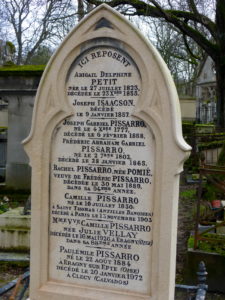 The Final Footprint – Pissarro was entombed in the Cimetière du Père Lachaise, Paris, Ile-de-France Region, France, the largest cemetery in the city of Paris (44 hectares or 110 acres). Père Lachaise is in the 20th arrondissement and is notable for being the first garden cemetery, as well as the first municipal cemetery. It is the site of three World War I memorials. The cemetery is on Boulevard de Ménilmontant. The Paris Métro station Philippe Auguste on line 2 is next to the main entrance, while the station called Père Lachaise, on both lines 2 and 3, is 500 metres away near a side entrance. Many tourists prefer the Gambetta station on line 3, as it allows them to enter near the tomb of Oscar Wilde and then walk downhill to visit the rest of the cemetery. Other notable Final Footprints at Père Lachaise include; Guillaume Apollinaire, Honoré de Balzac, Georges Bizet, Jean-Dominique Bauby, Maria Callas, Chopin, Colette, Auguste Comte, Jean-Baptiste-Camille Corot, Max Ernst, Molière, Jim Morrison, Édith Piaf, Marcel Proust, Sully Prudhomme, Gioachino Rossini (see above), Georges-Pierre Seurat, Simone Signoret, Gertrude Stein, Dorothea Tanning, Alice B. Toklas, Oscar Wilde, and Richard Wright.
The Final Footprint – Pissarro was entombed in the Cimetière du Père Lachaise, Paris, Ile-de-France Region, France, the largest cemetery in the city of Paris (44 hectares or 110 acres). Père Lachaise is in the 20th arrondissement and is notable for being the first garden cemetery, as well as the first municipal cemetery. It is the site of three World War I memorials. The cemetery is on Boulevard de Ménilmontant. The Paris Métro station Philippe Auguste on line 2 is next to the main entrance, while the station called Père Lachaise, on both lines 2 and 3, is 500 metres away near a side entrance. Many tourists prefer the Gambetta station on line 3, as it allows them to enter near the tomb of Oscar Wilde and then walk downhill to visit the rest of the cemetery. Other notable Final Footprints at Père Lachaise include; Guillaume Apollinaire, Honoré de Balzac, Georges Bizet, Jean-Dominique Bauby, Maria Callas, Chopin, Colette, Auguste Comte, Jean-Baptiste-Camille Corot, Max Ernst, Molière, Jim Morrison, Édith Piaf, Marcel Proust, Sully Prudhomme, Gioachino Rossini (see above), Georges-Pierre Seurat, Simone Signoret, Gertrude Stein, Dorothea Tanning, Alice B. Toklas, Oscar Wilde, and Richard Wright.
Gallery
-
-

Le chemin, c. 1864
-
-
-

Châtaignier à Louveciennes, 1870, Musée d’Orsay, Paris
-
-
-
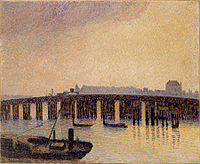
Old Chelsea Bridge, London 1871, Smith College Museum of Arts
-
-
-

Camille Pissarro, portrait of Paul Cézanne, National Gallery
-
-
-
Un Carrefour à l’Hermitage, Pontoise, 1876, Musée Malraux
-
-
-

Toits rouges, coin d’un village, hiver, Côte de Saint-Denis, Pontoise, 1877, Musée d’Orsay, Paris
-
-
-

The Artist’s Palette with a Landscape, c.1878, Clark Art Institute
-
-
-

Washerwoman, Study, 1880, The Metropolitan Museum of Art
-
-
-
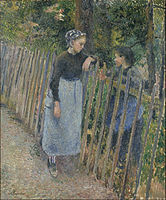
Conversation, c. 1881, National Museum of Western Art
-
-
-

The Harvest, 1882, Bridgestone Museum of Art, Tokyo
-
-
-

The Church at Eragny, 1884, Walters Art Museum
-
-
-

Bergère rentrant des moutons (Shepherdess Bringing in Sheep) 1886, University of Oklahoma
-
-
-
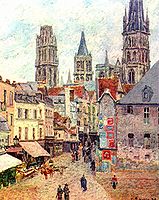
Rouen, Rue de l’Épicerie, 1898, private collection
-
-
-

La Place due Théâtre Français, 1898, Los Angeles County Museum of Art
-
-
-

View of Rouen, 1898, Honolulu Museum of Art
-
-
-

Morning, Winter Sunshine, Frost, the Pont-Neuf, the Seine, the Louvre, Soleil D’hiver Gella Blanc, c. 1901, Honolulu Museum of Art
-
-
-

Hay Harvest at Éragny, 1901, National Gallery of Canada, Ottawa
-
-
-

Le Jardin de Mirbeau aux Damps, Octave Mirbeau’s garden in Damps, 1891
-
-

Place du Havre, Paris, 1893, Art Institute of Chicago
-
- ”Boulevard Montmartre” cityscape series
-
-

Boulevard Montmartre à Paris, 1897
-
-
-

Boulevard Montmartre, morning, cloudy weather, National Gallery of Victoria, 1897
-
-
-
-
The Boulevard Montmartre on a Winter Morning, 1897, Metropolitan Museum of Art
-
-
-
-
-

Le Boulevard de Montmartre, Matinée de Printemps, street view from hotel window, 1897
-
-
-

Boulevard Montmartre la nuit, 1898
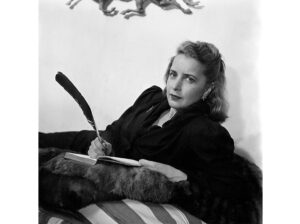 On this day in 1952 writer of children’s books, including Goodnight Moon and The Runaway Bunny, both illustrated by Clement Hurd, Margaret Wise Brown died in Nice, France at 42 of an embolism. She has been called “the laureate of the nursery” for her achievements. Born 23 May 1910 in Brooklyn.
On this day in 1952 writer of children’s books, including Goodnight Moon and The Runaway Bunny, both illustrated by Clement Hurd, Margaret Wise Brown died in Nice, France at 42 of an embolism. She has been called “the laureate of the nursery” for her achievements. Born 23 May 1910 in Brooklyn.
Brown’s first published children’s book was When the Wind Blew, published in 1937 by Harper & Brothers. Impressed by Brown’s “here and now” style, W. R. Scott hired her as his first editor in 1938. Through Scott, she published the Noisy Book series among others. As editor at Scott, one of Brown’s first projects was to recruit contemporary authors to write children’s books for the company. Ernest Hemingway and John Steinbeck neglected to respond, but Brown’s hero Gertrude Stein accepted the offer. Stein’s book The World is Round was illustrated by Clement Hurd, who had previously teamed with Brown on W. R. Scott’s Bumble Bugs and Elephants, considered “perhaps the first modern board book for babies”. Brown and Hurd later teamed on the children’s book classics The Runaway Bunny and Goodnight Moon, published by Harper. In addition to publishing a number of Brown’s books, under her editorship W. R. Scott published Edith Thacher Hurd’s first book, Hurry Hurry, and Esphyr Slobodkina’s classic Caps for Sale.
From 1944 to 1946, Doubleday published three picture books written by Brown under the pseudonym “Golden MacDonald” (coopted from her friend’s handyman) and illustrated by Leonard Weisgard. Weisgard was a runner-up for the Caldecott Medal in 1946, and he won the 1947 Medal for Little Lost Lamb and The Little Island. Two more of their collaborations appeared in 1953 and 1956, after Brown’s death. The Little Fisherman, illustrated by Dahlov Ipcar, was published in 1945. The Little Fur Family, illustrated by Garth Williams, was published in 1946. Early in the 1950s she wrote several books for the Little Golden Books series, including The Color Kittens, Mister Dog, and Scuppers The Sailor Dog.
 The Final Footprint – While on a book tour in Nice, France, she died shortly after surgery for a ruptured appendix. Kicking up her leg to show her nurses how well she was feeling caused a blood clot that had formed in her leg to dislodge and travel to her heart. Her cremated remains were scattered at her island home, “The Only House,” in Vinalhaven, Maine.
The Final Footprint – While on a book tour in Nice, France, she died shortly after surgery for a ruptured appendix. Kicking up her leg to show her nurses how well she was feeling caused a blood clot that had formed in her leg to dislodge and travel to her heart. Her cremated remains were scattered at her island home, “The Only House,” in Vinalhaven, Maine.
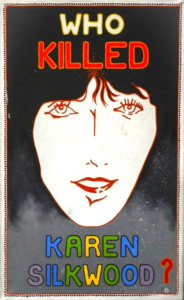 On this day in 1974 chemical technician and labor union activist Karen Silkwood died in a car crash under unclear circumstances near Crescent, Oklahoma at the age of 28. Born Karen Gay Silkwood on February 19, 1946 in Longview, Texas. Primarily known for raising concerns about corporate practices related to health and safety of workers in a nuclear facility. Following her mysterious death her estate filed a lawsuit against chemical company Kerr-McGee, which was eventually settled for $1.38 million. Her story was chronicled in Mike Nichols‘s 1983 Academy Award-nominated film Silkwood in which she was portrayed by Meryl Streep.
On this day in 1974 chemical technician and labor union activist Karen Silkwood died in a car crash under unclear circumstances near Crescent, Oklahoma at the age of 28. Born Karen Gay Silkwood on February 19, 1946 in Longview, Texas. Primarily known for raising concerns about corporate practices related to health and safety of workers in a nuclear facility. Following her mysterious death her estate filed a lawsuit against chemical company Kerr-McGee, which was eventually settled for $1.38 million. Her story was chronicled in Mike Nichols‘s 1983 Academy Award-nominated film Silkwood in which she was portrayed by Meryl Streep.
She worked at the Kerr-McGee Cimarron Fuel Fabrication Site plant near Crescent, Oklahoma, United States. Silkwood’s job was making plutonium pellets for nuclear reactor fuel rods. This plant experienced theft of plutonium by workers during this era. She joined the union and became an activist on behalf of issues of health and safety at the plant as a member of the union’s negotiating team, the first woman to have that position at Kerr-McGee. In the summer of 1974, she testified to the Atomic Energy Commission about her concerns.
 The Final Footprint
The Final Footprint
Silkwood said she had assembled documentation for her claims, including company papers. She decided to go public with this evidence, and contacted David Burnham, a New York Times journalist, who was interested in her story. On November 13, 1974, Silkwood left a union meeting at the Hub cafe in Crescent. Another attendee of that meeting later testified that Silkwood had a binder and a packet of documents with her at the cafe. Silkwood got into her Honda Civic and headed alone for Oklahoma City, about 30 miles (48 km) away, to meet with Burnham, the New York Times reporter, and Steve Wodka, an official of her union’s national office. Later that evening, Silkwood’s body was found in her car, which had run off the road and struck a culvert on the east side of State Highway 74, 0.11 miles (180 m) south of the intersection with West Industrial Road. The car contained none of the documents she had been holding in the union meeting at the Hub cafe. She was pronounced dead at the scene in what was believed to be an accident. The trooper at the scene remembers that he found one or two tablets of the sedative methaqualone (Quaalude) in the car, and he remembers finding cannabis. The police report indicated that she fell asleep at the wheel. The coroner found 0.35 milligrams of methaqualone per 100 milliliters of blood at the time of her death — an amount almost twice the recommended dosage for inducing drowsiness.
Some journalists have theorized that Silkwood’s car was rammed from behind by another vehicle, with the intent to cause an accident that would result in her death. Skid marks from Silkwood’s car were present on the road, suggesting that she was trying to get back onto the road after being pushed from behind.
Investigators also noted damage on the rear of Silkwood’s vehicle that, according to Silkwood’s friends and family, had not been present before the accident. As the crash was entirely a front-end collision, it did not explain the damage to the rear of her vehicle. A microscopic examination of the rear of Silkwood’s car showed paint chips that could have come only from a rear impact by another vehicle. Silkwood’s family claimed to know of no accidents of any kind that Silkwood had had with the car, and that the 1974 Honda Civic she was driving was new when purchased and no insurance claims were filed on that vehicle.
Silkwood’s relatives, too, confirmed that she had taken the missing documents to the union meeting and placed them on the seat beside her. According to her family, she had received several threatening phone calls very shortly before her death. Speculation about foul play has never been substantiated.
Because of concerns about contamination, the Atomic Energy Commission and the State Medical Examiner requested analysis of Silkwood’s organs by the Los Alamos Tissue Analysis Program.
Public suspicions led to a federal investigation into plant security and safety. National Public Radio reported that this investigation had found that 20 to 30 kilograms (44–66 lb) of plutonium had been misplaced at the plant.
Kerr-McGee closed its nuclear fuel plants in 1975. The Department of Energy (DOE) reported the Cimarron plant as decontaminated and decommissioned in 1994.
PBS Frontline produced the program, Nuclear Reaction, which included aspects of the Silkwood story. Its website for the program includes a summary of details entitled “The Karen Silkwood Story”, as printed November 23, 1995 in Los Alamos Science. The PBS program covered the risks of nuclear energy and raised questions about corporate accountability and responsibility.
Silkwood is interred in Danville Cemetery in Kilgore, Texas.
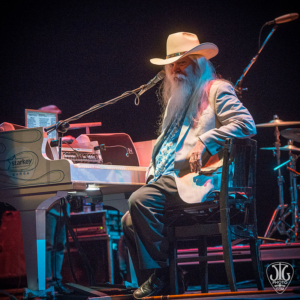 On this day in 2016, musician and songwriter Leon Russell died in his sleep at his suburban Nashville home in Mt. Juliet, Tennessee while recovering from heart surgery, at the age of 74. Born Claude Russell Bridges on April 2, 1942 in Lawton, Oklahoma. He was involved with numerous bestselling pop music records during his 60-year career. His genres included pop, country, rock, folk, gospel, bluegrass, rhythm and blues, folk rock, blues rock, surf, standards, and Tulsa Sound.
On this day in 2016, musician and songwriter Leon Russell died in his sleep at his suburban Nashville home in Mt. Juliet, Tennessee while recovering from heart surgery, at the age of 74. Born Claude Russell Bridges on April 2, 1942 in Lawton, Oklahoma. He was involved with numerous bestselling pop music records during his 60-year career. His genres included pop, country, rock, folk, gospel, bluegrass, rhythm and blues, folk rock, blues rock, surf, standards, and Tulsa Sound.
His collaborations rank as some of the most successful in music history, and as a touring musician he performed with hundreds of notable artists. He recorded 33 albums and at least 430 songs. He wrote “Delta Lady”, recorded by Joe Cocker, and organized and performed with Cocker’s Mad Dogs and Englishmen tour in 1970. His “A Song for You”, added to the Grammy Hall of Fame in 2018, has been recorded by more than 200 artists, and his “This Masquerade” by more than 75.
As a pianist, he played in his early years on albums by The Beach Boys, Dick Dale and Jan and Dean. On his first album, Leon Russell, in 1970, the musicians included Eric Clapton, Ringo Starr, and George Harrison. One of his biggest early fans, Elton John, said Russell was a “mentor” and an “inspiration”. They recorded their album The Union in 2010, which earned them a Grammy nomination.
Russell produced and played in recording sessions for, among others Bob Dylan, Frank Sinatra, Ike & Tina Turner, and The Rolling Stones. He wrote and recorded the hits “Tight Rope” and “Lady Blue”. He performed at The Concert for Bangladesh in 1971 along with Harrison, Dylan, and Clapton, for which he earned a Grammy Award.
His recordings earned six gold records. He received two Grammy awards from seven nominations. In 2011, he was inducted into both the Rock and Roll Hall of Fame and the Songwriters Hall of Fame.
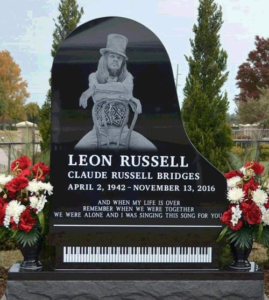 The Final Footprint
The Final Footprint
Russell’s funeral was on November 18 at Victory Baptist Church in Mt. Juliet, Tennessee, and a public memorial was held at The Oral Roberts University Mabee Center on November 20 in Tulsa, Oklahoma. He is interred at the Memorial Park Cemetery in Tulsa, Oklahoma.
Have you planned yours yet?
Follow TFF on twitter @RIPTFF




